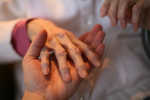FDA Approves Low-Level Laser for Osteoarthritis

(NewsUSA) - Osteoarthritis, a degenerative disease in which joint cartilage wears away over time, proves a common problem. According to the Centers for Disease Control and Prevention (CDC), approximately one-third of American adults suffer from chronic arthritis.
The pain of osteoarthritis not only affects Americans' joints, but also their wallets. Thirty-three percent of American workers report that arthritis interferes with their ability to perform their job. In 2007, treating arthritis cost $128 billion -- $81 billion in direct expenses, like medical costs, and another $47 billion in lost wages and other indirect costs.
Osteoarthritis typically affects older adults, but it does not affect every senior citizen. It can strike any animal with a bony skeleton, causing pain and disability.
"No one needs to describe that the pain comes and goes, prevents sleep, makes walking difficult, causes you to drop or spill things, and renders you unable to sign your name or write," writes Dr. Larry Lytle in his book, "Universal Healer: Book I Osteoarthritis." "In short, it is the most common form of disability."
Osteoarthritis cannot currently be cured, but effective treatments can improve the quality of life of millions of people. To many people, it comes as exciting news that the FDA has recently approved a low-level laser treatment, the QLaser, for treating osteoarthritis in the hands.
The Q1000 is a Class I laser device that has been classified by the FDA as a non-significant risk device as related to eye injuries, yet helps the body release endorphins (natural painkillers) reduce inflammation, increase circulation, help heal damaged cell membranes and boost cells' energy levels, resulting in less pain and more healing. Keeping a personal laser, like the QLaser, at home can help patients address their osteoarthritis without turning to costly medical treatments.
